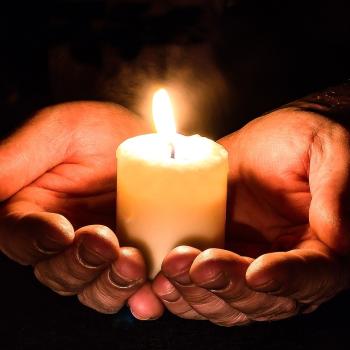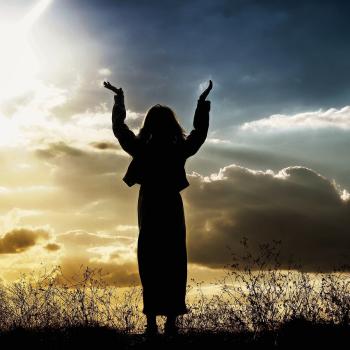The previous essay on prayer (7/8/2023) ended with the question – How else might we pray?
Non-conceptual Prayer
The “1.0” model of prayer is fairly easy to understand. We have all experienced needs and desires that we could not fulfill on our own, so we needed to request a person of greater power and authority to do so. Yet if our spiritual/evolutionary journey is now opening a deeper understanding of the cosmos, who we are, and how we fit within the grand scheme, more opportunity and responsibility may lay before us. And this likely occurs on dimensions more fundamental than rational thought and concept.
Though we in the West often look upon older shamanic, aboriginal, mystical rituals and practices as primitive, these are attempts to engage with subtle, meta-reality on a non-conceptual basis — and thereby may actually be closer to the mark.
Meditation practice and philosophies such as Buddhism center around the cessation of rational thought — the “monkey mind” that continually hops from one memory, idea, plan, desire, annoyance, goal, etc, etc, to another. Whether clearly understood or not, the goal of meditation is likely to turn down the conceptual noise, such that there might be an opening to more subtle dimensions of experience.
The paradox is that this too can be a random, shoot-in-the-dark process. A meditation teacher who once served as interpreter for the Dali Lama reported that His Holiness once asked: “With your background in the sciences, can you perhaps find a way to accelerate the process such that it might not take some several decades of practice on the cushion?”
The hope of this paper then is, as we attain a better experiential knowing of what we are doing in prayer, and the metaphysical context in which it is occurring, our engagement with deeper realms of the cosmos may be facilitated. Yet again the challenge: attempting to describe non-conceptual knowing through the medium of language and concepts. The following is an attempt to lay some conceptual groundwork from which an experiential knowing might emerge more intuitively.
The Interface of Prayer with Experienced Reality – How does it “work”?
Although modern science, being tied to the physical world, cannot provide a direct understanding of metaphysics, it may at least point by analogy in an insightful direction.
Quantum Field Theory in particular may be a helpful model. As described earlier in this paper, the latest thinking in theoretical physics holds that fields are the fundamental structure of the universe as we experience it. The particles that make up the material realm are essentially ripples or “blips” that occur in their corresponding field — which itself is universal and unbounded. While material things can be pointed to, measured, and worked with, the fields of which they are comprised are themselves not “things”. They are simply spheres of potential. Matter is something that the fields are “doing”, with the result of making that potential actual.
What is the impetus of that “doing”? According to the popular interpretation of Quantum Mechanics, the range of possible states in a field resolves or “collapses” to a stable fixed state (also known as “decoherence”) when an observation or measurement is made. In conventional Western science, that observation may simply be the interaction of physical systems — be they living or mechanical. Yet the notion that simple observation causes an alteration in the physical universe may seem a bit mystical/magical (resulting in Einstein’s quip: “Does the Moon exist because a mouse looks up at it?”)
In a consciousness-primary reality however, there are no independent, standalone, preexisting objects to be altered. There is no “collapse” other than the collapse or focus of attention on one particular subset in a range of perceptual events.
The above pertains at all levels of consciousness — individual subjectivity to cosmic (“God”) consciousness. As indicated earlier in this paper, we live in a stable, commonly shared experience of the world owing to Consciousness at a transpersonal or universal level. It is far beyond the ability of any creature or computer to assemble the uncountable trillions upon trillions of quantum events necessary to produce even the simplest phenomena we can perceive.
At the human end of the scale, we do have the ability to manipulate some of the above-created phenomena to conceive, design, and build things — and to create an experience of life and society according to our own needs and vision.
Prayer 2.0 lies somewhere between the two conceptual domains, mortal and divine. In fact, it is the interface between them. Accordingly, in addition to the changes and outcomes we can effect in daily life through direct physical action, to the extent that we can turn up the slider of consciousness in the transcendental direction, changes more supernormal to conventional reality might become possible. (Or in the old language: “prayers might be answered”.)
Co-Creating Reality
The disciples came to him and asked, “Why do you speak to the people in parables?”
He replied, “The knowledge of the secrets of the kingdom has been given to you, but not to them.
This is why I speak to them in parables: Though seeing, they do not see; though hearing, they do not hear or understand.”
— Matthew 13:10-13
Given that conventional language is not able to adequately conceptualize dimensions of reality above and beyond spacetime, we will here try to follow the Jesus approach of using analogy. Two analogies will hopefully point in an illuminating direction: the digital motion picture and the flow of currents in a river. These correspond roughly to “space” and “time”.
The Digital Motion Picture
Digital movies provide a surprisingly apt and easily understood analogy for the way the world and the “drama” of life is constructed.
A digital film projector or display screen is composed of about 40 million “pixels” – tiny points of light with one quality (color) and two states (on or off). During the course of a movie, each pixel is on or off in a certain pattern. Watching two hours of one pixel would make for a boring story, yet when the encoded information stored on a DVD or digital file switches groups of pixels in a coordinated pattern, any sort of image perceptible to the human eye might be portrayed. Further, when these patterns are put in a proper sequence, any story can be told.
Taking a cue from Jesus: “The story of the world is like …” a digital movie, wherein the pixels are three-dimensional, exist at the Planck scale, and the frame-rate is the Planck second. (If you’re not familiar, these are the smallest measurable units for distance and time.)
Managing this number of reality pixels moment by moment would be a task far beyond our ability even to comprehend – but fortunately, we don’t have to. Nature/ God/ Cosmic Consciousness has provided us with prepackaged pixel-modules in the form of subatomic particles, atoms, matter, and eventually the physical objects and living systems we are born into.
From this head-start we can then go on to weave these modules into the societies, economies, and lives as we so choose.
The Implications for Prayer 2.0
Working with physical components (“modules”) and interacting with people in the material world is something we all know how to do. Prayer enters when we are called upon to create or change something beyond normal capability. In this analogy, Prayer 1.0 was like asking a film editor/animator to make specific changes to a scene. Prayer 2.0 would be similar to use of a programming tool (e.g. Photoshop) to make a mass set of changes with a few simple instructions.
Life as a Flowing River
The progression of life is often likened to a river of time. A large river generally has many sub-currents, rapids, vortices, eddies, stagnant pools. Some of these will enable a boater to reach a destination safely, others may crash on the rocks, while still others may leave one dead-in-the-water, going nowhere.
If the boat operator is not aware or familiar with the nature of the river, he or she will simply be carried along at random, and by chance may or may not reach a desired destination. Although control of the river itself and the destination to which it leads is beyond the power of the boater, with sufficient awareness and understanding of the currents, he or she may at least navigate to the currents that are most favorable to reaching the hoped for destination.
In the context of a 2.0 understanding of prayer, while control of reality and the flow of the river of life as a whole is not possible, we may attempt to navigate to the sub-currents and event-lines that lead to more favorable outcomes.
Yet how to distinguish these, and how to engage with them?













